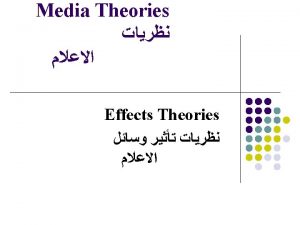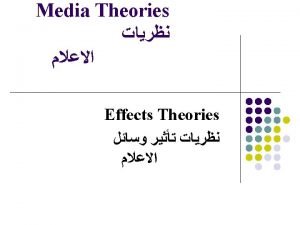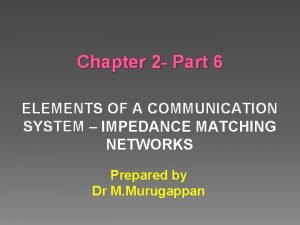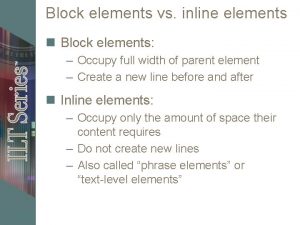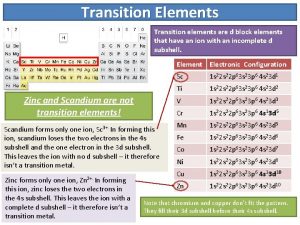Chapter 2 Part 7 ELEMENTS OF A COMMUNICATION







































- Slides: 39

Chapter 2 - Part 7 ELEMENTS OF A COMMUNICATION SYSTEM – RECEIVER Prepared by Dr M. Murugappan

Topics Covered Basic Principles of Signal Reproduction Superheterodyne Receivers Frequency Conversion Intermediate Frequency and Images Noise Typical Receiver Circuits Receivers and Transceivers

Topics Covered Basic Principles of Signal Reproduction Superheterodyne Receivers Frequency Conversion Intermediate Frequency and Images Noise Typical Receiver Circuits Receivers and Transceivers

Basic Principles of Signal Reproduction In radio communication systems, the transmitted signal is very weak when it reaches the receiver, particularly when it has traveled over a long distance. • The signal has also picked up noise of various kinds. • Receivers must provide the sensitivity and selectivity that permit full recovery of the original signal. •

Basic Principles of Signal Reproduction • A communication receiver must be able to identify and select a desired signal from the thousands of others present in the frequency spectrum (selectivity) and to provide sufficient amplification to recover the modulating signal (sensitivity). • A receiver with good selectivity will isolate the desired signal and greatly attenuate other signals. • A receiver with good sensitivity involves high circuit gain. • The radio receiver best suited to this task is known as the superheterodyne receiver.

Selectivity – Defined by the extend to which the receiver is capable to differentiating the desired signal and other frequencies. – Selectivity in a receiver is obtained by using tuned circuits and/or filters. – LC tuned circuits provide initial selectivity. – Filters provide additional selectivity. – By controlling the Q of a resonant circuit, you can set the desired selectivity. – The optimum bandwidth is one that is wide enough to pass the signal and its sidebands but narrow enough to eliminate signals on adjacent frequencies.

Selectivity (contd) Figure 1: Selectivity curve of a tuned circuit.

Selectivity (contd) › The sides of a tuned circuit response curve are known as skirts. › The steepness of the skirts, or the skirt selectivity, of a receiver is expressed as the shape factor, the ratio of the 60 -d. B down bandwidth to the 6 -d. B down bandwidth. › The lower the shape factor, the steeper the skirts and the better the selectivity.

Sensitivity – ability to pick up weak signals at the receiver – It’s a function of overall gain, the factor by which an input signal is multiplied to produce the output signal. – The higher the gain of a receiver, the better its sensitivity. – High gain in receivers is obtained by using multiple amplification stages. – The more gain that a receiver has, the smaller the input signal necessary to produce a desired level of output.

Sensitivity (contd) – Another factor that affects the sensitivity of a receiver is the signal-to-noise (S/N) ratio (SNR). – One method of expressing the sensitivity of a receiver is to establish the minimum discernible signal (MDS). – The MDS is the input signal level that is approximately equal to the average internally generated noise value. – This noise value is called the noise floor of the receiver. – MDS is the amount of signal that would produce the same audio power output as the noise floor signal.

Basic Receiver Configuration › The simplest radio receiver is a crystal set consisting of a tuned circuit, a diode (crystal) detector, and earphones. › The tuned circuit provides the selectivity. › The diode and a capacitor serve as an AM demodulator. › The earphones reproduce the recovered audio signal.

Basic Receiver Configuration (contd) Figure 2: The simplest receiver—a crystal set.

Tuned Radio Frequency (TRF) Receiver – In the tuned radio frequency (TRF) receiver sensitivity is improved by adding a number of stages of RF amplification between the antenna and detector, followed by stages of audio amplification. – The RF amplifier stages increase the gain before it is applied to the detector. – The recovered signal is amplified further by audio amplifiers, which provide sufficient gain to operate a loudspeaker.

Tuned Radio Frequency (TRF) Receiver Figure 3: Tuned radio-frequency (TRF) receiver.

Tuned Radio Frequency (TRF) Receiver – Many RF amplifiers use multiple tuned circuits. – Whenever resonant LC circuits tuned to the same frequency are cascaded, overall selectivity is improved. – The greater the number of tuned stages cascaded, the narrower the bandwidth and the steeper the skirts. – The main problem with TRF receivers is tracking the tuned circuits. – In a receiver, the tuned circuits must be made variable so that they can be set to the frequency of the desired signal. – Another problem with TRF receivers is that selectivity varies with frequency.

Superheterodyne Receivers • Superheterodyne receivers convert all incoming signals to a lower frequency, known as the intermediate frequency (IF), at which a single set of amplifiers is used to provide a fixed level of sensitivity and selectivity. • Gain and selectivity are obtained in the IF amplifiers. • The key circuit is the mixer, which acts like a simple amplitude modulator to produce sum, carrier and difference of the input frequencies. • The incoming signal is mixed with a local oscillator signal.

Superheterodyne Receivers Figure 4: Block diagram of a superheterodyne receiver.

SR- RF AMPLIFIER (1/2) RF Amplifier › The antenna picks up the weak radio signal and feeds it to the RF amplifier, also called a low-noise amplifier (LNA). › RF amplifiers provide some initial gain and selectivity and are sometimes called preamplifiers. › RF stage is also acts like a preselector to select a specific range of signal from entire bandwidth. › Several amplifiers connected in series are cascade mode is used as RF amplifier in receiver. › Tuned circuits help to select the frequency range in which the signal resides. › Special transistors and other components with low noise characteristics are selected. › Bipolar and FETs can be used as RF amplifiers.

SR- RF AMPLIFIER (2/2) The task of the RF amplifier is complicated › The received signal is not constant but varies continuously as a result of fading, changes in atmospheric conditions. This will affects the proper functioning of receiver system › Solution is given by Automatic Gain Control (AGC) It must take the received signal and leave out the variations. This is achieved by adjusting the gain of the RF stage as needed to maintain the desired constant output level.

SR – MIXER AND LOCAL OSCILLATOR Mixers and Local Oscillators – The output of the RF amplifier is applied to the input of the mixer. – The mixer also receives an input from a local oscillator or frequency synthesizer. – The mixer and oscillator work together to take the signal from the RF stage and convert it to the Intermediate Frequency (IF). – A tuned circuit at the output of the mixer selects the sum and difference frequency, or IF. – The local oscillator is made tunable so that its frequency can be adjusted over a relatively wide range.

Frequency Conversion • Frequency conversion is the process of translating a modulated signal to a higher or lower frequency while retaining all the originally transmitted information. • In radio receivers, high-frequency signals are converted to a lower, intermediate frequency. This is called down conversion. • In satellite communications, the original signal is generated at a lower frequency and then converted to a higher frequency. This is called up conversion.

Frequency Conversion Mixing Principles › Frequency conversion is a form of amplitude modulation carried out by a mixer circuit or converter. › The function performed by the mixer is called heterodyning.

Frequency Conversion Principles of Mixing: – Mixers accept two inputs: The signal to be translated to another frequency is applied to one input, and the sine wave from a local oscillator is applied to the other input. – Like an amplitude modulator, a mixer essentially performs a mathematical multiplication of its two input signals. – The output contains not only the carrier signal but also sidebands formed when the local oscillator and input signal are mixed.

Frequency Conversion Figure 5: Concept of a mixer.

Frequency Conversion Mixer and Converter Circuits: Diode Mixer › The primary characteristic of mixer circuits is nonlinearity. › Any device or circuit whose output does not vary linearly with the input can be used as a mixer. › One of the most widely used types of mixer is the simple diode modulator.

Frequency Conversion Mixer and Converter Circuits: Diode Mixer – The input signal is applied to the primary winding of the transformer. – The signal is coupled to the secondary winding and applied to the diode mixer, and the local oscillator signal is coupled to the diode by way of a capacitor. – The input and local oscillator signals are linearly added and applied to the diode, which produces the sum and difference frequencies. – The output signals are developed across the tuned circuit which selects the difference frequency.

Frequency Conversion Figure 6: A simple diode mixer.

Frequency Conversion Types of Mixer and Converter Circuits: – Single balanced mixer: A popular mixer circuit using two diodes. – Double balanced mixer: This version of the diode balanced modulator is probably the single best mixer available, especially for VHF, UHF, and microwave frequencies. – FET Mixers: FETs make good mixers because they provide high gain, have low noise, and offer a nearly perfect square-low response.

Frequency Conversion Mixer and Converter Circuits: IC Mixer – The NE 602, a typical IC mixer, is also known as a Gilbert transconductance cell or Gilbert cell. – It consists of a double balanced mixer circuit made up of two cross-connected differential amplifiers. Mixer and Converter Circuits: Image Reject Mixer – An image reject mixer is a special type of mixer used in designs in which images cannot be tolerated. – It uses Gilbert cell mixers in a configuration like that used in a phasing-type SSB generator.

Frequency Conversion Figure 7: NE 602 IC mixer. (a) Block diagram and pinout. (b) Simplified schematic.

Frequency Conversion Figure 8: A frequency synthesizer used as a receiver local oscillator

Intermediate Frequency and Images The primary objective in the design of an IF stage is to obtain good selectivity. Narrow-band selectivity is best obtained at lower frequencies. At low frequencies, circuits are more stable with high gain. At low frequencies, image interference is possible. An image is an RF signal two times the IF above or below the incoming frequency.

Intermediate Frequency and Images At higher frequencies, circuit layouts must take into account stray inductances and capacitances. At higher frequencies, there is a need for shielding. Figure 9: Relationship of the signal and image frequencies.

Intermediate Frequency and Images Figure 10: Signal, local oscillator, and image frequencies in a superheterodyne.

Intermediate Frequency and Images Solving the Image Problem › To reduce image interference, high-Q tuned circuits should be used ahead of the mixer or RF amplifier. › The IF is made as high as possible for effective elimination of the image problem, yet low enough to prevent design problems. › In most receivers the IF varies in proportion to the frequencies that must be covered.

Intermediate Frequency and Images Figure 11: A low IF compared to the signal frequency with low-Q tuned circuits causes images to pass and interfere.

SR – IF AMPLIFIER IF Amplifiers – The output of the mixer is an IF signal containing the same modulation that appeared on the input RF signal. – The signal is amplified by one or more IF amplifier stages, and most of the gain is obtained in these stages. – Selective tuned circuits provide fixed selectivity. – Since the intermediate frequency is usually lower than the input frequency, IF amplifiers are easier to design and good selectivity is easier to obtain.

SR – AUTOMATIC GAIN CONTROL Automatic Gain Control (contd) – The amplitude of the RF signal at the antenna of a receiver can range from a fraction of a microvolt to thousands of microvolts; this wide signal range is known as the dynamic range. – Typically, receivers are designed with very high gain so that weak signals can be reliably received. – However, applying a very high-amplitude signal to a receiver causes the circuits to be overdriven, producing distortion and reducing intelligibility. – With AGC, the overall gain of the receiver is automatically adjusted depending on the input signal level. – AGC circuits help maintain a constant output level over a wide range of RF input signal levels

SR - DEMODULATOR Demodulators › The highly amplified IF signal is finally applied to the demodulator, which recovers the original modulating information. › The demodulator may be a diode detector (for AM), a quadrature detector (for FM), or a product detector (for SSB). › The output of the demodulator is then usually fed to an audio amplifier.
 Part part whole addition
Part part whole addition Unit ratio definition
Unit ratio definition Part part whole
Part part whole Define technical description
Define technical description Bar parts
Bar parts The phase of the moon you see depends on ______.
The phase of the moon you see depends on ______. Part to part variation
Part to part variation Story elements part 1
Story elements part 1 Literary technical and performance elements of drama
Literary technical and performance elements of drama Oracle landed cost management
Oracle landed cost management Molecular element
Molecular element Http //elements.wlonk.com/elements table.htm
Http //elements.wlonk.com/elements table.htm Folk tale elements
Folk tale elements Folktales elements
Folktales elements Lesson 2 elements of communication
Lesson 2 elements of communication Therapeutic communication conversation examples
Therapeutic communication conversation examples Elements of mass communication
Elements of mass communication Mass media introduction
Mass media introduction Retail communication mix in retail management
Retail communication mix in retail management Basic elements of communication
Basic elements of communication N communication
N communication Les éléments fondamentaux de la communication
Les éléments fondamentaux de la communication Communication skills for sales
Communication skills for sales Communica definition
Communica definition 6 elements of communication
6 elements of communication Communication process
Communication process Freins à la communication interpersonnelle
Freins à la communication interpersonnelle Explain the communication process in detail
Explain the communication process in detail Parallel and serial communication
Parallel and serial communication What is oral communication and written communication
What is oral communication and written communication Parallel communication
Parallel communication Mass communication
Mass communication Meaning of oral communication
Meaning of oral communication Serial communication vs parallel communication
Serial communication vs parallel communication Why did scout rub walter cunningham’s nose in the dirt?
Why did scout rub walter cunningham’s nose in the dirt? Maus 2 chapter 1
Maus 2 chapter 1 Chapter review motion part a vocabulary review answer key
Chapter review motion part a vocabulary review answer key Gulliver travels book 3
Gulliver travels book 3 What are some of the things bob ewell starts doing?
What are some of the things bob ewell starts doing? Chapter 9 modals part 1
Chapter 9 modals part 1
















